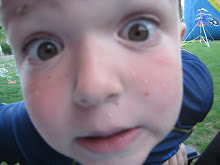All Eyes On Megan
We finally had our second opinion appointment regarding Megan's eyes. The first doctor had said that she has a mild case of strabismus, and the second doctor echoed the first, almost word-for-word. The formal diagnosis is "intermittent exotropia", which simply means that her right eye turns out sometimes, and then snaps back into alignment with the other eye. Read more here: exotropia Having caught it this early, there is really nothing to be concerned about. If it had gone undiagnosed until, say, age 4 or 5, it could have led to ambliopia, which means one eye gets really weak from disuse (the brain stops using the turned eye, because it causes double vision, and the brain doesn't like this). When you see kids with a patch on one eye, that is likely the cause--their strong eye is being covered to force the weak eye to be used.
The strategy from here is to do some basic exercises with her once a day, and to be seen again in 4-6 months. The stats are: 2-3 percent of all people have strabismus, i.e. it's very common. Of those, 10% will improve on their own, 50-55% will stay the same, and 30-35% will get worse. If it improves, great. If it stays the same, the doctor will continue to use refraction to see whether both eyes are being used. If they are, we can let it alone. If they are not, glasses and/or surgery are likely in order to correct the problem before ambliopia kicks in. If it gets worse, glasses and/or surgery will be used to fix the alignment.
Should surgery be necessary, it is a 45-minute outpatient procedure, with 2-3 hours of recovery. It would require general anesthesia, with full monitoring and intubation. This is because pressure on the eye (during surgery) involves the Vagus nerve, which can cause a drop in heart rate when stimulated. So all the peripheral stuff is more precautionary, so the doctors can react if needed, though unlikely. Overall, it's a fairly non-invasive procedure.
While the functional considerations are paramount, we were also concerned about the social implications for Megan, i.e. being the kid with the lazy eye. Kathryn and I both knew kids like this growing up, and it wasn't pleasant for them. The doctor today was very much in tune with this, and feels that even if the function is good, the social side is important enough all by itself to do the surgery. This is all a ways off--surgery wouldn't be until around age 3-5 if it's needed at all.
So the bottom line of all this is that we'll wait and see, with regular checkups. We have two good doctors to choose from, which is a nice change of pace. It's always hard to find the good ones when you move somewhere new!


1 Comments:
been through all of this with my now 16 year old boy ,he has to wear gleass after t trips to the cutting rome as he got older he was going to have to go again and he decide to put a stop to the cutting . after time the eyes change there shap! and futher changes woll be come posible nessery . owl
Post a Comment
<< Home